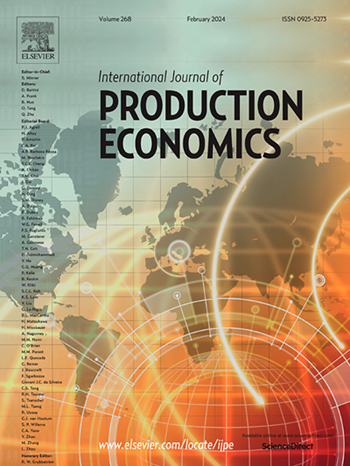A divergent two-echelon spare part inventory system with lost sales and compound Poisson demand
IF 10
1区 工程技术
Q1 ENGINEERING, INDUSTRIAL
引用次数: 0
Abstract
This paper investigates a spare parts inventory system in a two-echelon supply chain following a continuous review process. The first echelon has a central warehouse, while the second has multiple local warehouses. The demand for spare parts at the local warehouses follows a Compound Poisson Process. A base-stock policy controls inventory in the supply chain with demand satisfied within a pre-determined waiting time threshold. Failure to do so will result in lost sales, which happens when stockouts occur at both echelons and there is no inventory in transit. The lead time at the central warehouse is a random variable following a general distribution. Empirical evidence suggests that the Compound Poisson Process provides a more accurate fit for the lumpy and intermittent demand of spare parts compared to the Poisson process, which is the approach often adopted in the literature. This paper follows a queueing network modeling approach to find the inventory performance measures in closed-form when the lead time at the central warehouse follows a general distribution. We minimize supply chain costs and improve performance by determining the optimum inventory levels at the central and local warehouses. We simulated our model and found that the numerical results deviated by a maximum of 5.84% error compared to the results from closed-form expressions.
具有销售损失和复合泊松需求的发散两级备件库存系统
本文研究了一个具有连续评审过程的两级供应链中的备件库存系统。第一梯队有一个中央仓库,而第二梯队有多个本地仓库。当地仓库对备件的需求遵循复合泊松过程。基本库存策略控制供应链中在预先确定的等待时间阈值内满足需求的库存。如果做不到这一点,就会导致销售损失,当两个梯队都出现缺货,并且没有库存在运输时,就会发生这种情况。中心仓库的交货时间是一个遵循一般分布的随机变量。经验证据表明,与泊松过程相比,复合泊松过程对备件的块状和间歇性需求提供了更准确的拟合,这是文献中经常采用的方法。本文采用排队网络建模的方法,寻找中心仓库交货时间服从一般分布时的封闭式库存绩效度量。我们通过确定中央和本地仓库的最佳库存水平来最大限度地降低供应链成本并提高绩效。我们对模型进行了模拟,发现数值结果与封闭形式表达式的结果相比,偏差最大为5.84%。
本文章由计算机程序翻译,如有差异,请以英文原文为准。
求助全文
约1分钟内获得全文
求助全文
来源期刊
CiteScore
21.40
自引率
7.50%
发文量
266
审稿时长
52 days
期刊介绍:
The International Journal of Production Economics focuses on the interface between engineering and management. It covers all aspects of manufacturing and process industries, as well as production in general. The journal is interdisciplinary, considering activities throughout the product life cycle and material flow cycle. It aims to disseminate knowledge for improving industrial practice and strengthening the theoretical base for decision making. The journal serves as a forum for exchanging ideas and presenting new developments in theory and application, combining academic standards with practical value for industrial applications.

 求助内容:
求助内容: 应助结果提醒方式:
应助结果提醒方式:


